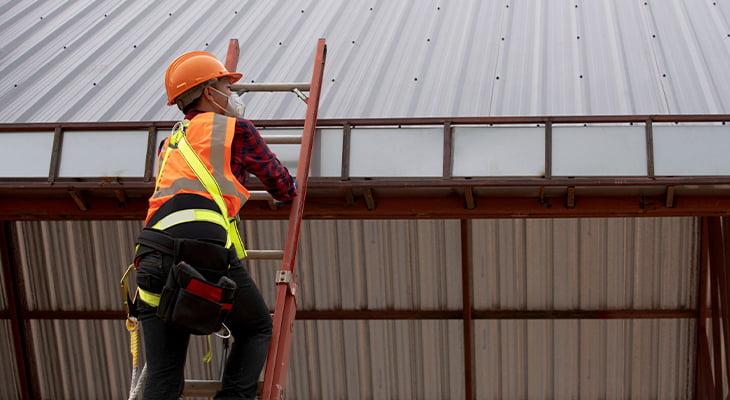
Metal roofing is a durable and energy-efficient option for industrial buildings, but it also poses some safety challenges for the workers who install it. Metal roofing contractors must follow the best safety practices in industrial metal roof installation, such as wearing proper protective equipment, using appropriate tools and techniques, and complying with the relevant codes and standards.
This blog post will discuss the importance of these safety measures and provide tips from expert metal roofing contractors to ensure a safe and successful installation.
Fall Protection Protocols
One of the most common and serious safety risks in industrial metal roofing installation is falling from heights. Therefore, metal roofing contractors need to follow the fall protection protocols and use the appropriate equipment to prevent or minimize the impact of falls.
Some of the fall protection equipment that metal roofing contractors should use include:
- Harnesses and lanyards: These devices attach the worker to a secure anchor point or a lifeline and prevent them from falling more than a few feet. Harnesses and lanyards should be inspected regularly and replaced if damaged or worn out.
- Guardrails and nets: These barriers prevent workers from falling off the roof’s edges or into openings. Guardrails and nets should be installed along the roof’s perimeter and around any skylights, vents, or other openings.
- Personal fall arrest systems (PFAS): These are systems that consist of a harness, a lanyard, an anchor point, and a shock absorber. PFAS is designed to stop a worker’s fall within a short distance and reduce the force of the impact.
Material Handling Guidelines
Another safety challenge in industrial metal roof installation is handling and transporting metal roofing materials, such as panels, fasteners, and flashing. Metal roofing contractors should follow the material handling guidelines and use the appropriate tools and techniques to move and position the metal roofing materials safely.
Some of the material handling tools and techniques that metal roofing contractors should use include:
- Carts and dollies: These devices help workers transport metal roofing materials from the ground to the roof or from one location to another on the roof. Carts and dollies should be sturdy, stable, and equipped with brakes and straps to secure the load.
- Cranes and hoists: These machines lift and lower the metal roofing materials using cables, chains, or ropes. Cranes and hoists should be operated by trained and certified workers and inspected and maintained regularly.
- Gloves and protective clothing: These items protect workers from cuts, abrasions, and burns caused by the metal roofing materials. Gloves and protective clothing should be durable, heat-resistant, and fit snugly without restricting movement.
Anchoring And Stability Measures
A third safety issue in industrial metal roof installation is ensuring the anchoring and stability of the metal roofing system. Metal roofing systems are subject to various forces, such as wind, snow, and thermal expansion, that can cause them to shift, buckle, or detach from the roof deck. Some of the anchoring and stability materials and methods that metal roofing contractors should use include:
- Fasteners and clips: These devices attach the metal roofing panels to the roof deck or each other and resist the uplift and lateral forces caused by wind and snow. Fasteners and clips should be compatible with the metal roofing materials and installed according to the manufacturer’s specifications.
- Sealants and flashings: These materials seal the gaps and joints between the metal roofing panels and the roof deck and prevent water, air, and moisture infiltration. Sealants and flashings should be compatible with the metal roofing materials and applied in sufficient quantity and quality to ensure a watertight and airtight seal.
- Expansion and contraction allowances: These measures account for the thermal movement of the metal roofing materials and prevent them from cracking, warping, or tearing due to temperature changes. Expansion and contraction allowances should be based on the coefficient of thermal expansion of the metal roofing materials.
Choosing The Best: Selecting Metal Roofing Contractors
When installing an industrial metal roof, finding the right contractor is crucial for a successful and durable outcome. Metal roofing offers durability, energy efficiency, and longevity, but its effectiveness heavily relies on proper installation. When facing Metal Roof Maintenance Challenges, finding the right contractors becomes paramount.
Selecting the best metal roofing contractor involves several considerations. Look for contractors with extensive experience, specifically in metal roofing. Check their portfolio for past projects and inquire about their certifications or affiliations with reputable industry bodies.
Ensure they possess proper licensing and insurance, safeguarding you from liabilities during installation. Additionally, ask for references and testimonials from previous clients to gauge their work quality and professionalism.
About Stahl Roof Systems
Welcome to Stahl Roof Systems, your certified metal roofing authority in Edmonton. Our dedicated contractors boast top-tier qualifications, extensive expertise, and an unwavering commitment to fulfilling all your roofing requirements. At Stahl Roof Systems, our priority is delivering unparalleled customer service. Discover our comprehensive range of services and expertise by visiting us today.
Are you looking for seasoned experts in metal roof installation? Contact us now and elevate your roofing standards with our exceptional services.
